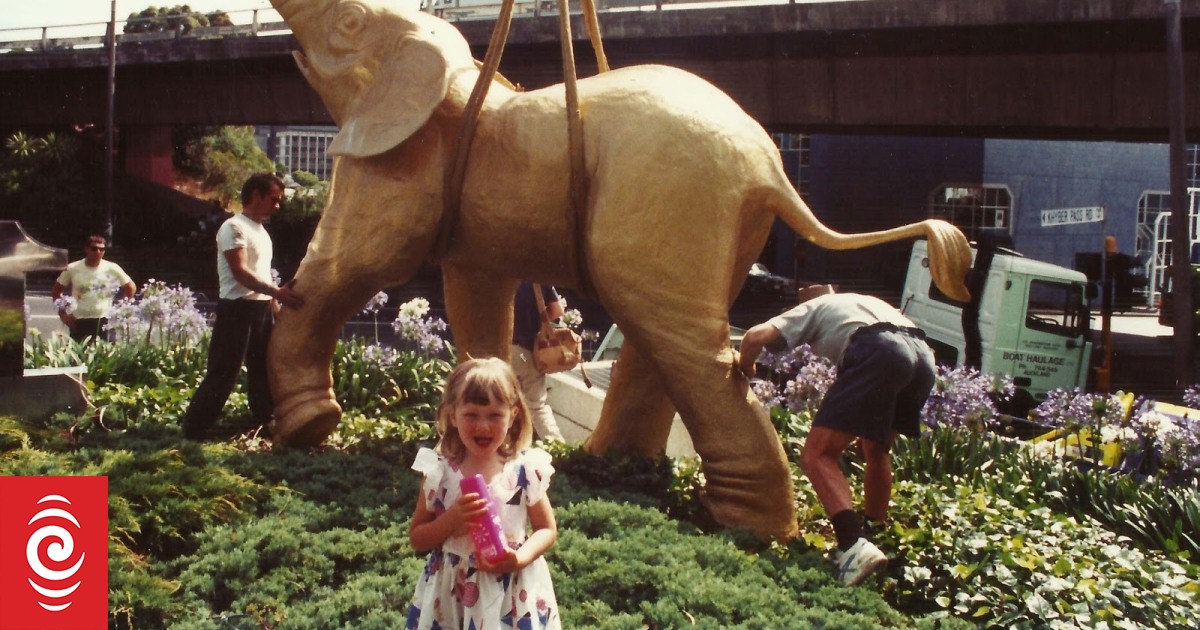
Abdul the elephant now looks out over the Pacific Ocean instead of the traffic jams of Khyber Pass.
Photo: Supplied / Kate Harris
A life-sized elephant – familiar to generations of Aucklanders – has traded its home of more than 30 years next to a traffic-clogged central city road for a quiet life overlooking the Pacific Ocean.
The gold, and later red, elephant has long been a popular landmark on Khyber Pass Road, where it stood guard, its trunk raised defiantly, outside the Red Elephant Thai Restaurant.
However, even an elephant’s might proved no match in the end for economic forces and rising inner-city rents.
Last week, as New Zealand’s longest-running Thai restaurant closed its doors for the last time, the 1.2-tonne ferrocement elephant was lifted from its foundations and transported to Northland.
It is now enjoying a well-earned retirement in the seaside settlement of Langs Beach.
The elephant’s new owner, Peter Harris, said he had frequented the restaurant for 20 years and had become close friends with owner Abdul Bashota.
“A few weeks ago he told me the shattering news that he was having to close the restaurant after 43 years. It’s been pretty tough over the past two or three years in hospitality, and then his rent doubled, so it just wasn’t sustainable,” Harris said.
The demise of the restaurant left the sculpture in need of a new home.

Peter Harris with the red elephant at Langs Beach, shortly after their circuitous journey from Auckland’s Khyber Pass.
Photo: RNZ / Peter de Graaf
“So I said to Abdul, look, rather than let the elephant be shifted off to some industrial section somewhere and deteriorate, I’ll take it up to Langs Beach and give it a nice home. And that’s exactly what happened.”
Harris named the elephant in his old friend’s honour, and had “a bit of an adventure” getting Abdul (the elephant, not the restaurant owner) home.
“We had to take a very circuitous route north because it was too high to go on the Harbour Bridge and the motorway. It’s incredibly well built – we tried to take a bit of the trunk off so we’d be able to get onto the motorway. Despite going through three grinder blades, we couldn’t get it off, so we gave up.”
It took Harris and his son almost six hours to drive Abdul from central Auckland to Langs Beach, near Waipū, where it has a glorious view across Bream Bay and the Pacific Ocean.
Harris has positioned the elephant near his letterbox and plans to surround it with a field of yellow day lilies.
“I think the neighbours are going to love it,” he said.

The red elephant is lowered into place at its new home in Langs Beach.
Photo: Supplied / Kate Harris
Harris said he already had a lot of art in his garden but Abdul was special.
“It’s probably its size, its stature. It’s 4.3 metres to the tip of its trunk. Big is best I think. And the colour, It’s a bit out there. Some people wanted me to put it back to the original gold, but that’s a bit glitzy for me.”
Harris offered to return the elephant if Bashota was able to find new premises and open another restaurant.
“But he said, ‘No, all I want is to be able to bring my grandson, once he’s born, and show him the elephant and maybe put him up on it and take a photo’.”
The elephant was made in 1991 by Harmen Hielkema, who was working for an Auckland signwriting company called Signing On at the time.
Hielkema built all manner of big things, from a monstrous Avondale spider to a three-metre-tall dog named Toby and a giant chainsaw.
The elephant was built with a steel skeleton wrapped in chicken wire and coated in cement.

The elephant takes shape in Harmen Hielkema’s workshop.
Photo: Supplied / Harmen Hielkema
Hielkema said the elephant, which was originally painted gold, was made to promote Chang Thong Thai Restaurant. It was repainted when the restaurant was renamed The Red Elephant in 2006.
Over the years the sculpture had lost its original context and had become an Auckland icon, he said.
Hielkema, who now lives in Whangārei, was pleased his creation had found a good home in Northland.
“I think it’s fantastic,” he said.
Hielkema made one other elephant, Sati, as an educational display for Auckland Zoo.
Completed in 1992, Sati, a female Asian elephant, was originally sliced in half so zoo-goers could observe its muscles, bones and organs.
Since 2013, Sati had enjoyed a peaceful retirement, innards no longer on public view, in a remote corner of South Hokianga, also in Northland.
“Not many people have the opportunity to build two elephants in their lifetime, one African and one Asian,” Hielkema said.
“And even fewer people can say both their elephants have followed them back to Northland.”

The elephant, at that time painted gold, is lowered into its original position next to Auckland’s Khyber Pass.
Photo: Supplied / Harmen Hielkema



